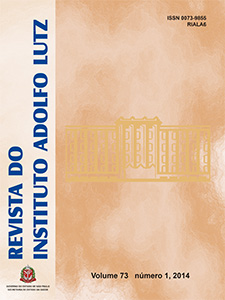Abstract
Acute infectious disease of viral etiology, the rabies, affects mammals including man, and it is characterized by neurological symptoms resulting from encephalopathy and it causes lethality of nearly 100 %. Being a zoonosis with different animal species serving as a reservoir, its control requires measures aimed at reducing the virus in species of greatest epidemiological relevance. In the city of Rio de Janeiro, the rabies is under epidemiological control at its urban form, where dogs are the main source of infection. However, recently this disease has been found in domestic animals such as horses, cattle and pigs, transmitted by haematophagous bats, and non-haematophagous bats, which is pointing to the importance of the wild cycle of rabies and the need for a better understanding of the epidemiological profile of this disease. This paper reports the occurrence of 14 cases of rabies in animals in the city of Rio de Janeiro in 2011 and 2012. It highlights the importance of the haematophagous bat Desmodus rotundus in disease transmission, describing the viral spreading in the municipal territory and the potential reintroduction of rabies in the city from the wild environment, which pose new challenges to public health professionals who work in this area.References
1. Acha PN, Szyfres B. Zoonosis y enfermidades transmissibles comunes al hombre y a los animales. Publicación Científica y Técnica No. 580. 3ª ed. Washington, DC: OPAS, 2001.
2. Secretaria de Vigilância em Saúde (Ministério da Saúde – Brasil) Raiva Humana Transmitida por Morcegos no Estado do Maranhão: Boletim Eletrônico Epidemiológico. Brasília, 2005. Disponível em: [http://bvsms.saude.gov.br/bvs/periodicos/boletim_eletronico_epi_ano04_n06.pdf].
3. Secretaria de Vigilância em Saúde (Ministério da Saúde – Brasil). Raiva. In: Guia de Vigilância Epidemiológica. Brasília: Ministério da Saúde; 2005. p.603-632.
4. Secretaria de Defesa Agropecuária (Ministério da Agricultura, Pecuária e Abastecimento - Brasil). Controle da Raiva dos herbívoros: manual técnico 2009. Brasilia: MAPA; 2009. 124 p.
5. Schneider, MC. Estudo de avaliação sobre área de risco para a Raiva no Brasil [dissertação de mestrado]. Rio de Janeiro (RJ): Escola Nacional de Saúde Pública da Fundação Oswaldo Cruz; 1990.
6. Belotto AJ. Situação da Raiva no Mundo e Perspectivas de Eliminação da Raiva Transmitida pelo Cão na América Latina. OPAS-Washington, D.C., EUA, 2009.
7. Sodre, MM, da Gama, AR, de Almeida MF. Lista atualizada das espécies de morcegos positivas para Raiva no Brasil. Rev Inst Med Trop São Paulo.2010;52(2):75-81.
8. World Health Organization - WHO. Animal Rabies. [acesso 2013 Mar 15]. Disponível em [http://www.who.int/rabies/human/en/].
9. OPAS (Organizacion Panamericana de la Salud). Plan de Acción para la Consolidación de la Fase de Ataque Final para la Eliminación de la rabia em las Américas Hasta el Año 2000. Documento de Trabajo. Washington,DC.: 1992.
10. Geografia do Rio de Janeiro. In: WIKIPÉDIA, a enciclopédia livre. Flórida: Wikimedia Foundation, 2014. [acesso em: 2014 apr 13] Disponível em: [http://pt.wikipedia.org/w/index.php?title=Geografia_do_Rio_de_Janeiro&oldid=38509327].
11. Deus GT, Becer M, Navarro IT. Diagnosis of rabies in nonhematophagous bats in Campo Grande City, Mato Grosso do Sul Centro Oeste do Brazil: report cases. Semin Cienc Agrarias.2003:24(1):171-6.
12. Cabral CC, Morais CAN, Dias AVAB, Araújo MG, Moreira CM, Mattos GLM. Circulation of the rabies virus in non-hematophagous bats in the City of Rio de Janeiro, Brazil, during 2001-2010. Rev Soc Bras Med Trop.2012;45(2):180-3.
13. Novais BAF, Zappa V. Raiva em Bovinos – Revisão de Literatura. Rev Elet Med Vet.2008;10(6):1-7.
14. Fernandes CG, Riet-Correa F. Raiva, In: Riet-Correa, F., Schild, A.L., Lemos, R.A.A. & Borges, J.R.J. (Eds), Doenças de Ruminantes e Equídeos. Vol.1. 3rd ed. Pallotti, Santa Maria. 2007.
15. Radostits OM, Gay CC, H Inchcliff KW. Clínica Veterinária. 9ª ed. Rio de Janeiro: Guanabara Koogan; 2002.

This work is licensed under a Creative Commons Attribution 4.0 International License.
Copyright (c) 2015 Instituto Adolfo Lutz Journal
